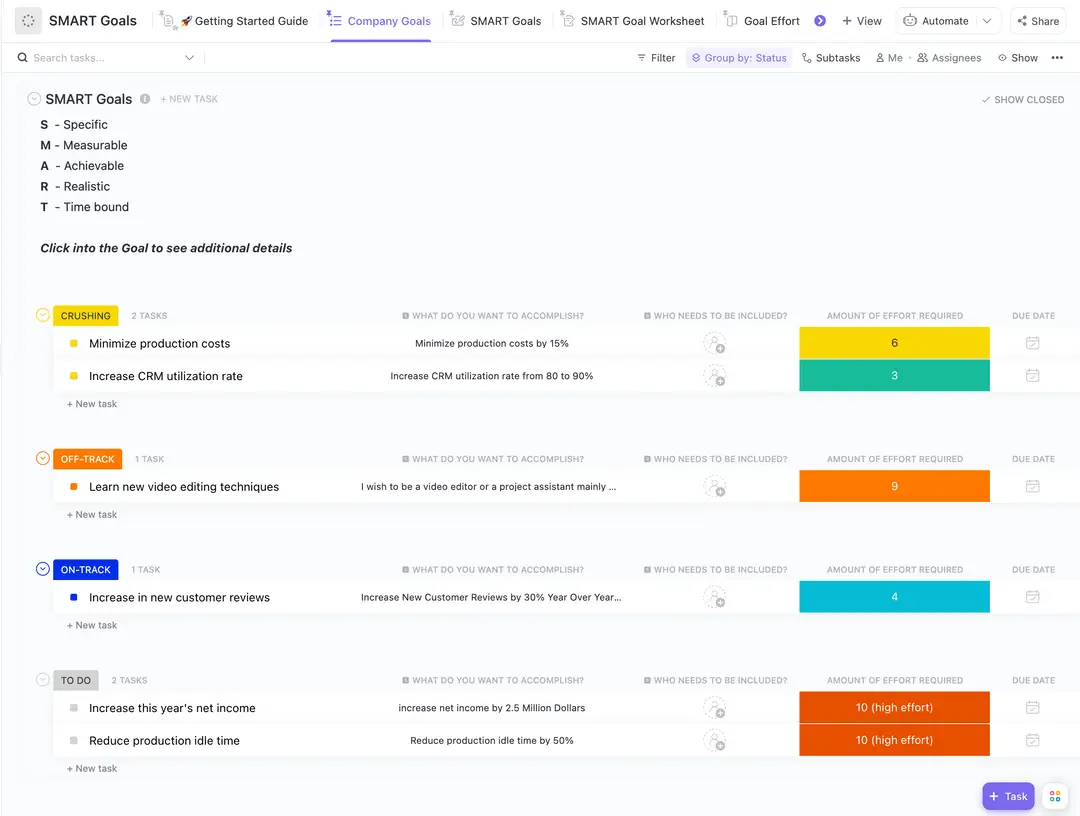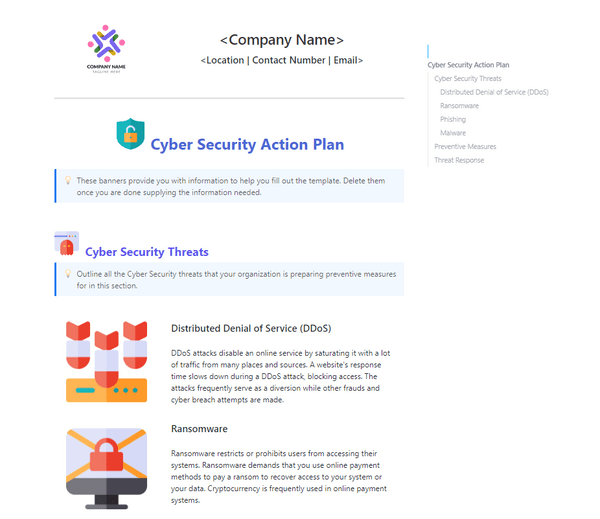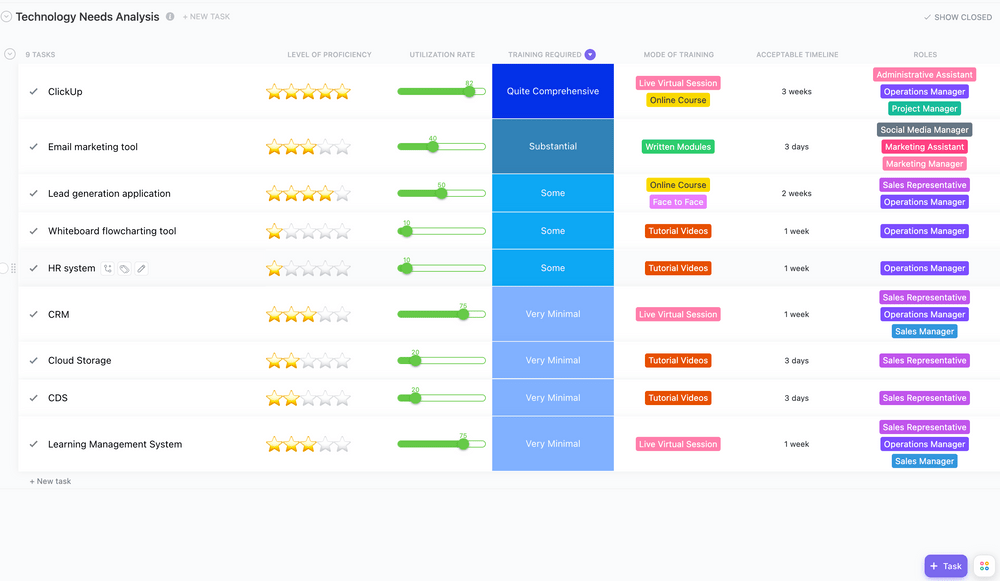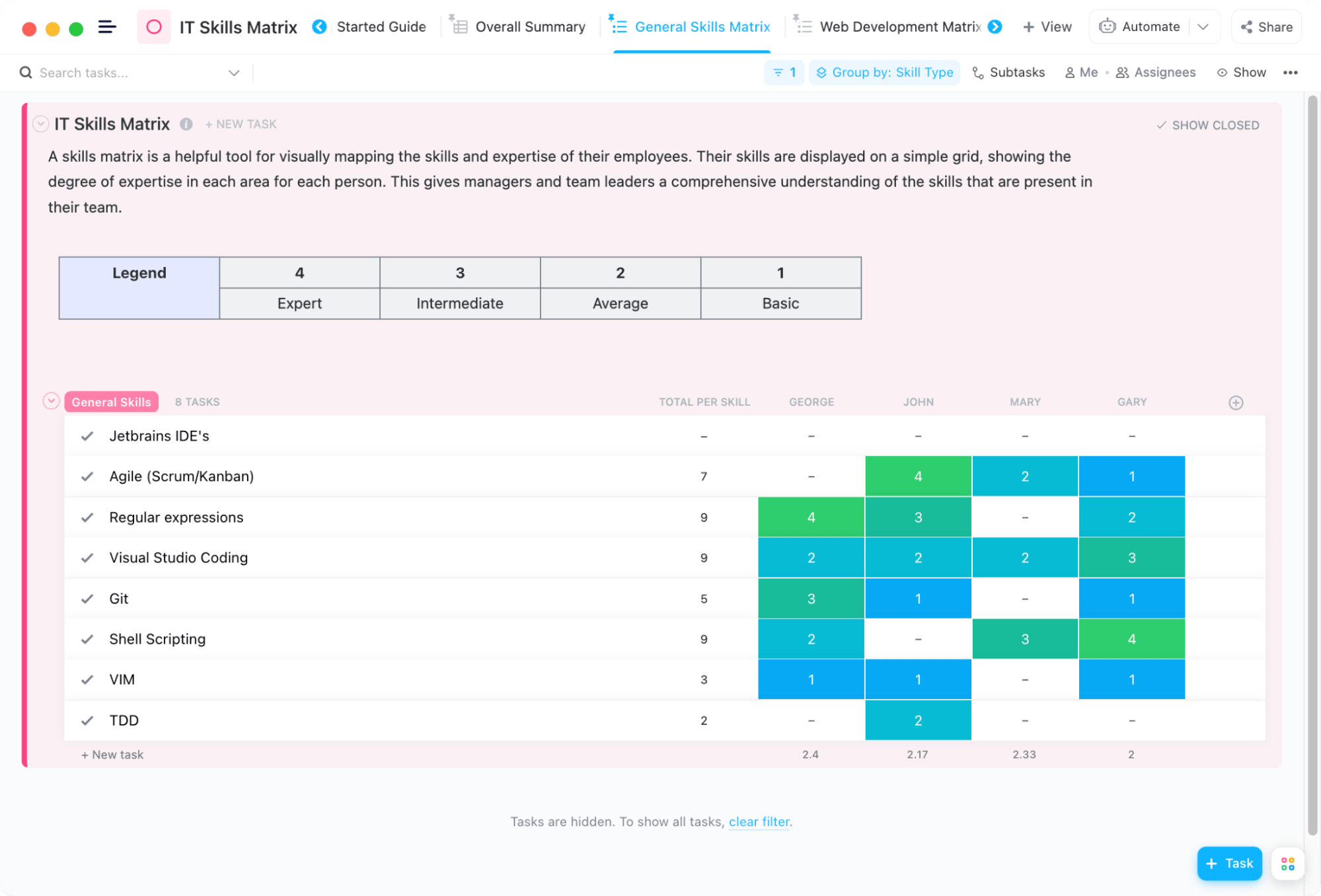في الرحلة المعقدة لتكنولوجيا المعلومات (تكنولوجيا المعلومات)، لا بد من وجود اتجاه واضح. لا يمكن لخطة عمل تقريبية أو أهداف عريضة لقسم تكنولوجيا المعلومات لديك أن تأخذك إلى هذا الحد. سواء كنت مديراً لتكنولوجيا المعلومات أو مدير أعمال، فأنت بحاجة إلى أهداف واضحة المعالم لتعرف بالضبط إلى أين يحتاج فريقك أن يذهب وكيف يصل إلى هناك.
إن وضع هدف قابل للقياس أو قابل للإدارة لفريق تكنولوجيا المعلومات لديك يمكن أن يحوّل أداءك من مُرضٍ إلى ممتاز، مما يمنح شركتك قوة في أي مجال تنافسي. ويضمن ذلك استخدام وقت وجهود فريق تكنولوجيا المعلومات لديك بكفاءة، ومعالجة المشاكل بسرعة، وإرضاء الجميع - بدءًا من قادة الأعمال وحتى موظفي تكنولوجيا المعلومات الأفراد. 🔥
سنتعرف في هذه المقالة على المزيد حول أهداف تكنولوجيا المعلومات وغاياتها، على المدى القصير والطويل. سنغطي:
- 10 أهداف لتكنولوجيا المعلومات تتماشى مع أنظمة تكنولوجيا المعلومات الحالية لديك
- مؤشرات الأداء الرئيسية المشتركة لقياس التقدم الذي يحرزه قسم تكنولوجيا المعلومات لديك
- عملية إنشاء أهداف محددة وتتبعها باستخدام أدوات مثل ClickUp، وهو حل لإدارة المشاريع لفرق تكنولوجيا المعلومات
ما هي أهداف تكنولوجيا المعلومات؟
أهداف تكنولوجيا المعلومات هي أهداف عمل محددة تهدف إلى ترقية وتحسين العمليات داخل قسم تكنولوجيا المعلومات في المؤسسة. وعادةً ما تكون جزءًا من إطار عمل حوكمة تكنولوجيا المعلومات يتماشى مع الأهداف العامة للمؤسسة ويدعمها.
على سبيل المثال، مع تقدم منافسيك من خلال اعتماد تقنيات جديدة، يصبح تحسين الكفاءة التشغيلية أحد أهداف العمل عالية المستوى لمؤسستك. قد يكون جزء من أهداف تكنولوجيا المعلومات المحددة هنا هو تنفيذ أدوات تكنولوجيا المعلومات المؤيدة للكفاءة لأتمتة المهام وتبسيط سير العمل. 🛠️
من المهم أن تتوافق أهداف قسم تكنولوجيا المعلومات لديك مع أهداف العمل الشاملة. في مثالنا السابق مع الكفاءة، يمكن أن يكون الهدف العام على مستوى القسم هو إنشاء تكنولوجيا المعلومات خرائط العمليات وإيجاد فرص لأتمتة المهام. تحديد الأهداف يكون فعالاً فقط عندما يكون مصحوبًا بأطر زمنية محددة ومؤشرات أداء رئيسية (KPIs) لقياس النجاح. لهذا السبب يستخدم العديد من قادة تكنولوجيا المعلومات إطار عمل أهداف SMART لتحديد الأهداف، حيث SMART هو اختصار يصف الأهداف على النحو التالي :
- محددة
- قابلة للقياس
- قابل للتحقيق
- ذات صلة
- محددة زمنياً
من المهم أيضًا تقدير الجهد والقيمة التي تجلبها أهداف تكنولوجيا المعلومات الخاصة بك حتى تتمكن من تحديد أولويات الخطط التي لها أكبر تأثير قابل للقياس على المؤسسة.
نصيحة إضافية: أنشئ أهدافًا ذكية لفرق تكنولوجيا المعلومات لديك باستخدام قالب خطة عمل أهداف SMART Goal Plan (انقر فوق) . وهو يوفر إطار عمل ممتاز لإنشاء أهداف محددة لتكنولوجيا المعلومات ومهام قابلة للتحقيق، مع أدوات مدمجة لتتبع المعالم الرئيسية.
تتبع وإدارة جميع أهدافك وغاياتك بتفاصيل دقيقة باستخدام قالب خطة عمل الأهداف الذكية ClickUp SMART Goal Action Plan
اطلع على المزيد من قوالب تحديد الأهداف !
ما هي فوائد تحديد أهداف تكنولوجيا المعلومات؟
عندما تقوم بتحديد أهداف تكنولوجيا المعلومات وترتيب أولوياتها بوضوح، يمكنك التمتع بفوائد مثل:
- المواءمة التنظيمية: تساهم جهود قسم تكنولوجيا المعلومات في نمو المؤسسة من خلال المساعدة في تحقيق الأهداف بكفاءة ونجاح
- تحسين عملية اتخاذ القرار: توفر أهداف تكنولوجيا المعلومات إطارًا موثوقًا يمكن الرجوع إليه عند اتخاذ القرارات الصعبة لجميع احتياجات عملك، والأهم من ذلك، عندماتخصيص الموارد أو تجديد الأنظمة الحالية
- تقييم الأداء: عندما تعرف ما يجب أن تسعى إليه، سيكون لديك مرجع لتتبع التقدم المحرز,تقييم الأداء، واكتشاف مجالات التحسين المستمر
- التركيز والتحفيز: من السهل أن تضيع في مهام تكنولوجيا المعلومات العادية وتنسى سبب قيامك بما تفعله. توفر أهداف تكنولوجيا المعلومات إحساسًا بالاتجاه والهدف، مما يحفز الفرق على العمل المتعمد
- الميزة التنافسية: عندما يكون العمل متناسقًا وفعالًا، يمكن للمؤسسة التكيف مع التغييرات والاتجاهات المستمرة ويكون لديها مجال للمناورة للابتكار بشكل أسرع واكتساب الزخم. وهذا يمكّن الشركة منالتفوق على المنافسين وتضع نفسها كشركة رائدة في السوق 👑
10 أمثلة على أهداف تكنولوجيا المعلومات لأقسام تكنولوجيا المعلومات
يجب أن تعكس أهداف تكنولوجيا المعلومات الخاصة بك احتياجات قسمك ومؤسستك. ولإضافة المزيد من الإلهام، دعنا نستكشف عشرة أهداف رائجة تركز عليها فرق تكنولوجيا المعلومات اليوم. 🌱
1. الأتمتة والكفاءة لتحسين عمليات الأعمال
بقيادة الذكاء الاصطناعي (AI) والتعلم الآلي (ML)، فإن التكنولوجيا المتطورة المتاحة اليوم لديها القدرة على تغيير طريقة عمل المؤسسات. إنه نوع من هدف لا مفر منه للاستفادة من تكنولوجيا الذكاء الاصطناعي/التعلم الآلي الناشئة من أجل تعميم عمليات تكنولوجيا المعلومات من النهاية إلى النهاية وتقليل الأخطاء. 🤖
واكب التطورات التكنولوجية في مجال عملك وكن منفتحًا على الأدوات، مثل برنامج أتمتة المهام التي يمكنها تحسين سير عملك. كلما أسرعت في أتمتة المهام المتكررة، كلما كان لديك المزيد من الوقت لأعمال أخرى ذات قيمة، مثل ابتكار أنظمة تكنولوجيا المعلومات والبنية التحتية.
على سبيل المثال، تتبنى العديد من الشركات الآن ClickUp وهو موقع مجاني عالي التصنيف أداة إدارة المشاريع مع مجموعة مخصصة من الميزات لفرق تكنولوجيا المعلومات . تأتي المنصة مع:
- أتمتة ClickUp لتسريع المهام اليدوية المتكررة
- منشئ النماذج ClickUp لجمع الأخطاء وطلبات المشكلات وتتبعها
- وظائف مثل الحقول المخصصة، ونقاط السبرنت، والمعالم، والتبعيات لتصميم تدفقات عمل مخصصة لأقسام تكنولوجيا المعلومات

اجمع الملاحظات وحوّلها تلقائيًا إلى مهام باستخدام نماذج ClickUp
وعلاوة على ذلك، يمكنك الاستمتاع بواحدة من أكثر مساعدو الذكاء الاصطناعي لتكنولوجيا المعلومات على المنصة: إن ClickUp Brain . يمكنه صياغة وتحرير وثائق تكنولوجيا المعلومات وإنشاء الملخصات، والعصف الذهني لأفكار المشاريع، والتعبئة التلقائية لبيانات الجداول، وكتابة رسائل البريد الإلكتروني للعملاء، وتلخيص النصوص وترجمتها لك.

يمكنك أتمتة كتابة الوثائق باستخدام الذكاء الاصطناعي، ومراقبة التقدم المحرز من خلال المخططات والمسابقات السريعة وحل أخطاء الترميز بسرعة باستخدام ClickUp
2. عزز جهود التعاون لتبسيط حياة قسم تكنولوجيا المعلومات لديك
إن ثقافات العمل عن بُعد والعمل المختلط هي حاضر ومستقبل تكنولوجيا المعلومات، ولكنها تجعل التعاون صعباً. لهذا السبب يعد تبني بيئة عمل مرنة أحد أهم أهداف تكنولوجيا المعلومات اليوم.
ولكن يجب ألا يأتي ذلك على حساب الإنتاجية.
قم بإنشاء إدارة تكنولوجيا المعلومات ثقافة قائمة على الخدمة الذاتية ولكن أيضًا تنفيذ الأدوات التي تعزز التواصل والتعاون الفعال عن بُعد. 🤝
يصادف أن يكونClickUp الأداة المثالية لـ التعاون عن بُعد . يسمح لك بـ إدارة المهام والموارد في منصة مركزية، مما يجعل العمل شفافًا ويمكن الوصول إليه من أي مكان.
مع ClickUp Whiteboards بأكملها يمكن لفريق تكنولوجيا المعلومات طرح الأفكار وإنشاء خرائط طريق في الوقت الفعلي. يمكنك أيضًا التواصل على الفور عبر عرض ClickUp Chat , خيوط التعليق و تضمين التغريدة دون مغادرة التطبيق.
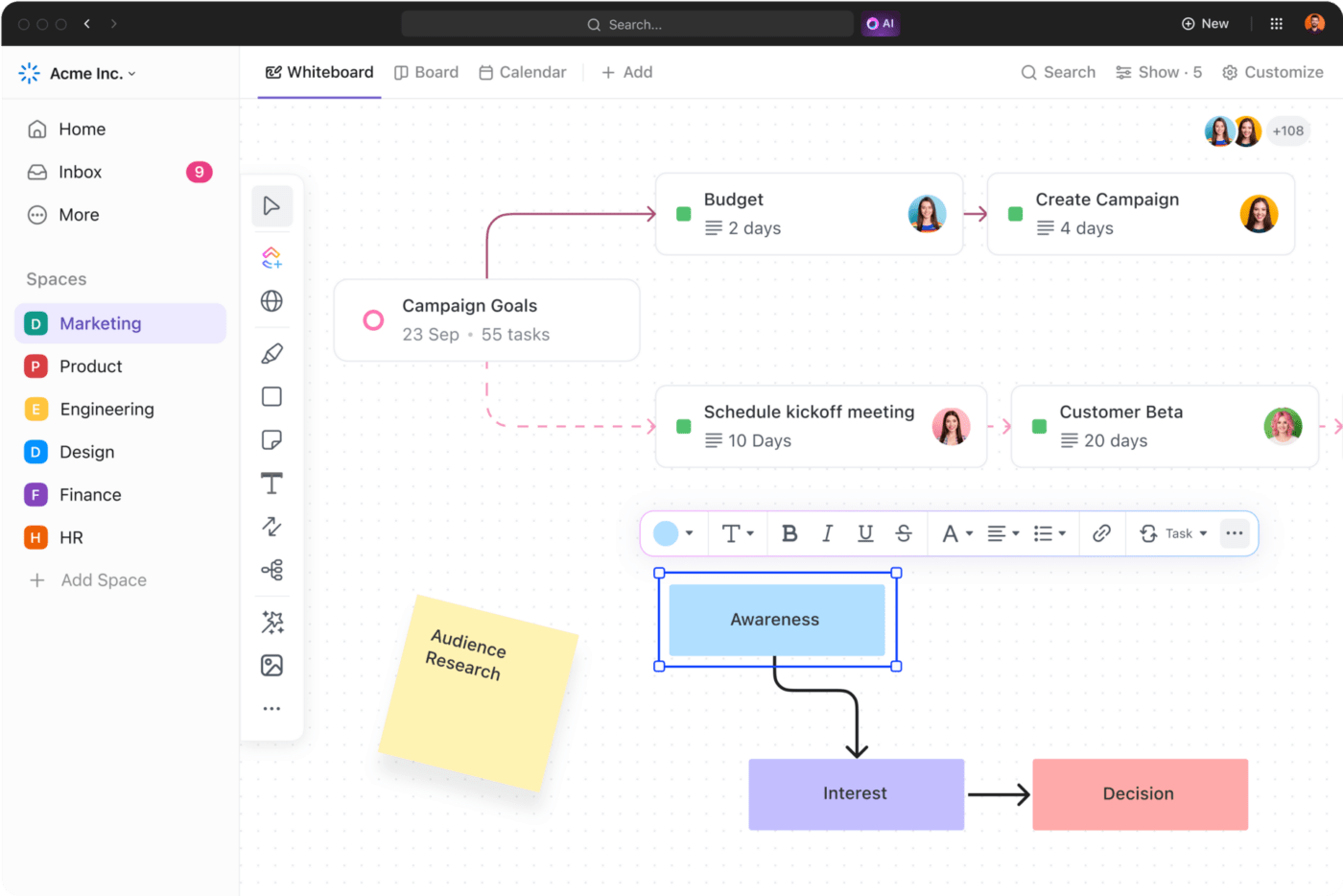
تعاون في اتخاذ أي قرار وحلل العمليات في الوقت الفعلي باستخدام ClickUp Whiteboards
من الضروري أن يكون لديك قاعدة معرفية التي يمكن لموظفي تكنولوجيا المعلومات لديك اللجوء إليها في جميع الأوقات. لحسن الحظ مستندات ClickUp يمكّنك من إنشاء مركز موارد تفاعلي لموارد الشركة وإجراءات التشغيل القياسية (SOPs). سيؤدي ذلك إلى تقليل الحاجة إلى الاجتماعات غير الضرورية والتشاور غير الضروري، مما يسمح للجميع بالتركيز على عملهم.
3. إعادة تقييم المكدس التقني لصقل استراتيجية عملك
تتطور احتياجات قسم تكنولوجيا المعلومات لديك مع توسع حجم العمل والبيانات. قد تصبح الأداة التي كانت ثورية من قبل غير مناسبة أو عفا عليها الزمن مع إصدار تقنية جديدة. 📟
يجب أن يكون أحد أهداف تكنولوجيا المعلومات لديك هو تقييم المكدس التقني بانتظام. ابحث عن التكنولوجيا الناشئة وحلل نظامك البيئي الحالي لاكتشاف أوجه القصور أو التكرار.
فبدلاً من التلاعب بأدوات فردية مختلفة، قد تحتاج إلى تنفيذ نظام موحد لجعل عملك أكثر انسيابية وقابلية للتطوير وفعالية من حيث التكلفة.
إليك مثالاً على ذلك: يمكن لمنصة شاملة مثل ClickUp أن تحل محل أدوات متعددة، بما في ذلك برنامج إدارة المهام والمشاريع, برنامج إصدار التذاكر , مجموعة إدارة علاقات العملاء (CRM) وأدوات تحرير النصوص والتواصل، وغيرها.
4. تحصين الأمن السيبراني بأحدث التقنيات المتطورة
مع تقدم التكنولوجيا، تتقدم التهديدات الإلكترونية. إذا لم يكن فريقك استباقيًا ويقظًا، فقد تتعرض سلامة وسرية البيانات الحساسة للخطر. يمكن أن يكون لمثل هذه الانتكاسة تأثير كبير على أهداف تكنولوجيا المعلومات لديك وكذلك على سمعة الشركة.
الهدف المحتمل: تنفيذ نظام أمني قوي للحفاظ على سلامة أعمالك وحماية البيانات الحساسة وضمان الامتثال التنظيمي. 🔒
تأكد من أن أنظمة تكنولوجيا المعلومات الجديدة الخاصة بك تتضمن:
- تدابير مثل تشفير البيانات والمصادقة الثنائية
- استراتيجيات تخفيف المخاطر، بما في ذلك إجراءات النسخ الاحتياطي والاسترداد
- عمليات التدقيق والتحديثات الأمنية المنتظمة
- التدريب على التوعية الأمنية
نصيحة: استخدم نموذج خطة عمل ClickUp للأمن السيبراني لتنظيم استراتيجية الأمن على مستوى شركتك في شكل منظم ومرن.
استخدام قالب خطة عمل الأمن السيبراني من ClickUp لإنشاء خطة تنفيذ منظمة ومفصلة للأمن السيبراني
5. البنية التحتية لتكنولوجيا المعلومات وترقية بنية المؤسسة
البنية التحتية لتكنولوجيا المعلومات هي أساس كل أعمال تكنولوجيا المعلومات. وبالمثل، يمكن أن تتسبب البنية المؤسسية القديمة في حدوث مشكلات مثل انخفاض أداء النظام.
لذا، فكر في تخصيص قدر كبير من الوقت والجهد لصيانة أنظمة تكنولوجيا المعلومات لديك وتحسينها. على سبيل المثال، يتزايد عدد الشركات اليوم التي تنتقل إلى الحلول السحابية لأنها تميل إلى أن تكون
- قابلة للتطوير: تسمح لك بتعديل الموارد بناءً على الطلب
- آمنة: تأتي مع تدابير أمنية صارمة وحلول التعافي من الكوارث
- فعالة من حيث التكلفة: عادةً ما يكون لديها نموذج تسعير الدفع حسب الاستخدام
- يمكن الوصول إليها: تسمح لك بالوصول إلى البيانات من أي مكان، مما يجعلها مناسبة للفرق البعيدة
عند الترحيل إلى السحابة، من المهم التخطيط للعملية والإشراف عليها بعناية لضمان نقل البيانات بسلاسة ومنع حدوث أي انقطاع. استخدم قالب تحليل احتياجات تقنية ClickUp لإضافة المزيد من الهيكلية لهذه العملية.
قم بتقييم احتياجات موظفيك التدريبية باستخدام نموذج تحليل الاحتياجات التقنية ClickUp
6. تقليل التكاليف لتحقيق أهداف الأعمال المالية
سواء كان ذلك بتعليمات مباشرة من الإدارة العليا أو بمبادرة داخلية، فإن خفض التكاليف هو هدف تواجهه فرق تكنولوجيا المعلومات بشكل متكرر. وعادةً ما يتعين عليهم التعاون مع فريق الشؤون المالية من أجل مواءمة استثمارات قسم تكنولوجيا المعلومات مع أهداف الشركة فيما يتعلق بالقدرات والإيرادات. 💰
لتقليل الإنفاق، يجب أولاً تتبع وتحليل الإنفاق الحالي. حدد المجالات التي تنطوي على أعلى التكاليف وقم بتقليص أي نفقات غير ضرورية. حاول التفاوض على صفقات أفضل مع البائعين أو مراجعة استراتيجية تخصيص الموارد الخاصة بك. يمكنك تحرير بعض الموارد عن طريق تنفيذ أتمتة تكنولوجيا المعلومات .
مع مجموعة ClickUp المالية يمكنك مراقبة نفقاتك ومواعيدك المالية بسهولة، وإجراء الحسابات التلقائية بناءً على البيانات الرقمية، وتتبع تقدمك نحو الإنفاق الفعال.
7. استثمر في تطوير المواهب للحفاظ على تحفيز فرق العمل وتنافسيتها
لا يجد المتخصصون الموهوبون في مجال تكنولوجيا المعلومات عادةً صعوبة في العثور على وظائف ذات رواتب جيدة، ولكن عليهم أن يصقلوا مهاراتهم باستمرار ليظلوا أكفاء.
أحد الأهداف الحاسمة للعديد من أقسام تكنولوجيا المعلومات هو إعادة تقييم مهارات الموظفين وتحديد الفجوات المعرفية وتوفير فرص للارتقاء بالمهارات المهنية. استثمر في برامج التدريب والشهادات والمؤتمرات. وبهذه الطريقة، يمكنك تمكين موظفي تكنولوجيا المعلومات لديك من تنويع مهاراتهم والبقاء على صلة باللعبة.
ومن المزايا الأخرى للتدريب أنه يخفف بعض الضغط عن مسؤولي التوظيف. فبدلاً من البحث عن موظفين جدد، يمكنك التركيز على إعداد موظفيك الحاليين لمهام أكثر صعوبة.
نصيحة: استخدم قالب مصفوفة مهارات تكنولوجيا المعلومات ClickUp لرسم خريطة مرئية لمهارات وخبرات فريق تكنولوجيا المعلومات الحالي لديك، مصنفة حسب الدور أو القسم، وتخطيط برامج التدريب.
تم تصميم هذا النموذج لمساعدتك في تحديد مهارات فريقك وتتبعها ومراقبتها
8. جودة البرامج ونشرها
إذا كان فريقك يقوم بتطوير البرمجيات وصيانتها، فقد يكون هدفك هو تحسين البرمجيات المذكورة. وتشمل هذه التحسينات ما يلي:
- طرح ميزات جديدة أو تحديث الميزات الحالية
- تمكين إمكانية الوصول عبر المنصات، مثل الويب أو الهاتف المحمول
- تحسين ضبطتصميم تجربة المستخدم (UX)
- الحد من أي عيوب، وتحسين عمليات التطوير وضمان الجودة
يمكنك الآن تبسيط عملية دورة حياة التطوير باستخدام ClickUp . استخدمه لبناء خرائط طريق واضحة، وتخطيط وتتبع سباقات السرعة وإدارة الأعمال المتراكمة وتتبع التقدم المحرز. يتكامل ClickUp مع مع مستودعات معروفة مثل GitHub و GitLab و Bitbucket، مما يسمح لك بمزامنة عملك بين المنصات.
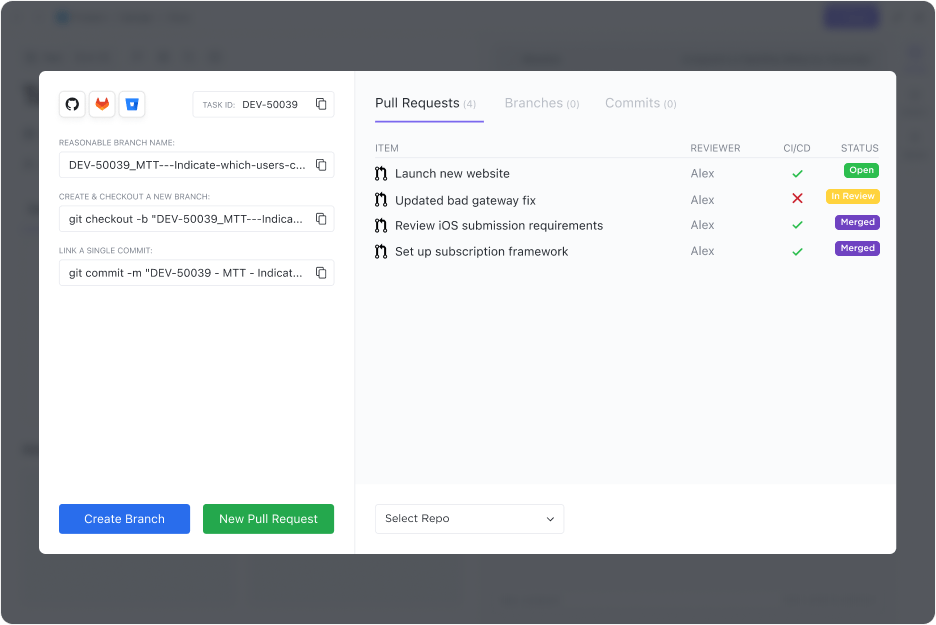
يمكن ل ClickUp التكامل مع GitHub وأكثر من 1,000 أداة أخرى لتبسيط التخطيط والتطوير
9. التحسين المستمر والابتكار للأعمال بأكملها
بغض النظر عن الصناعة، فإن تعزيز ثقافة التحسين الدائم أمر يستحق الثناء. فهو يسمح لك بالوصول إلى التميز التشغيلي والحفاظ عليه وتعزيزه. 📈
الخطوة الأولى لتحقيق هذه النتائج هي مراقبة التقدم والأداء. يجب عليك تحديد مؤشرات الأداء الرئيسية وتتبعها وجمع ملاحظات المستخدمين من البداية. يمكنك بعد ذلك تحليل هذه البيانات لتحديد الاختناقات، وتشكيل عملية صنع القرار وتحديد الأهداف في المستقبل.
يُعد النظر في بوابات التحسين المستمر هدفًا ممتازًا على المدى الطويل لأن القيام بذلك سيوسع نطاق قدراتك على حل المشاكل وجعل فريق تكنولوجيا المعلومات لديك مرنًا.
10. الاستدامة كجزء من أهدافك طويلة الأجل لتكنولوجيا المعلومات
أصبحت المخاوف البيئية أكثر انتشارًا، مما يضع ضغوطًا على الشركات لتكون مسؤولة اجتماعيًا. ♻️
صناعة تكنولوجيا المعلومات ليست استثناءً. يمكن لشركات وأقسام تكنولوجيا المعلومات الحد من تأثيرها البيئي بعدة طرق. تتضمن بعض الأهداف التي يجب مراعاتها ما يلي:
- تشجيع العمل عن بُعد: الحد من التنقل لخفض البصمة الكربونية
- احتضان الاقتصاد الدائري: إعادة استخدام وإصلاح وإعادة تدوير المواد لزيادة كفاءة استخدام الموارد وتقليل النفايات إلى أقصى حد ممكن
- الانتقال إلى التكنولوجيا والتصنيع الصديقين للبيئة: استخدام الأجهزة والمعدات التي تتمتع بتصنيفات وشهادات كفاءة الطاقة المثلى
- الاستثمار في مصادر الطاقة المتجددة: الاستفادة من الطاقة الشمسية أو طاقة الرياح لتلبية بعض أو كل احتياجاتها من الطاقة
- تحسين عملية التطوير: مراجعة ممارسات تطوير البرمجيات الخاصة بك بحيث تستلزم عمليات أقل استهلاكًا للموارد
مقاييس مؤشرات الأداء الرئيسية لتكنولوجيا المعلومات لتتبع أهداف قسم تكنولوجيا المعلومات
في حين يجب عليك قياس التقدم المحرز في تحقيق أهدافك قدر الإمكان، لا يمكنك الاهتمام بكل شيء. يجب عليك إعطاء الأولوية لتتبع بعض مؤشرات الأداء الرئيسية الأكثر صلة بأهدافك الحالية. 📚
فيما يلي، سنقوم بإدراج بعض أنواع المقاييس الأكثر شيوعًا عبر وظائف تكنولوجيا المعلومات، والتي قد ترتبط ببعض الأهداف التي ناقشناها سابقًا:
التشغيلية
لقياس الأداء التشغيلي والكفاءة، يمكنك استخدام:
- معدل نجاح المشروع: النسبة المئوية للمشاريع المنجزة في الوقت المحدد وفي حدود الميزانية وضمن المواصفات
- نسبة التذاكر المتقلبة: النسبة المئوية لإجمالي التذاكر المفتوحة والمفتوحة، مما يشير إلى النسبة المئوية للمهام غير المكتملة
- متوسط الوقت المستغرق في التعامل مع المشروع: مقدار الوقت الذي يحتاجه الفريق أو عضو الفريق عادةً لإكمال مهمة أو حل مشكلة ما
أنظمة تكنولوجيا المعلومات
استخدم مؤشرات الأداء الرئيسية التالية لمراقبة سلامة البنية التحتية والبرمجيات الخاصة بك:
- وقت التشغيل مقابل وقت التعطل: النسبة المئوية للوقت الذي تعمل فيه أنظمتك أو خوادمك مقابل عدم تشغيلها
- استخدام الخادم أو السحابة: قياس أداء النظام
- متوسط الوقت اللازم للإصلاح/التعافي: مقدار الوقت الذي يحتاجه فريق تكنولوجيا المعلومات عادةً لحل مشكلات النظام
الأمان
تتعلق هذه المؤشرات بالأمان و حوكمة البيانات التدابير:
- وقت الاسترداد/هدف نقطة الاسترداد: مقدار الوقت أو البيانات التي يمكن لمؤسستك تحمل خسارتها في حالة وقوع حادث
- الأيام منذ وقوع آخر حادث: مقدار الوقت الذي مضى منذ وقوع آخر حادث، مما يدل على فعالية الاستراتيجيات الأمنية المطبقة
- عدد الثغرات الأمنية المفتوحة: يستخدم لمراقبة مدى التعرض للتهديدات المحتملة
- معدل نجاح النسخ الاحتياطي: النسبة المئوية للبيانات التي تم نسخها احتياطيًا وعدد الأيام منذ آخر نسخة احتياطية
المالية
إذا كان هدف تكنولوجيا المعلومات لديك هو تحليل التكاليف وخفضها، يمكنك تتبع المقاييس التالية:
- إنفاق تكنولوجيا المعلومات مقابل الخطة: مقدار ميزانية تكنولوجيا المعلومات المتاحة التي تستخدمها وما إذا كنت تستخدمها بفعالية
- العائد على الاستثمار : المقارنة بين المكاسب والخسائر الناتجة عن استثمارات تكنولوجيا المعلومات
- الأموال التي تم توفيرها: مقدار المال الذي تم توفيره نتيجة للتفاوض على التكلفة وتوحيد الأدوات والتحول إلى حلول أكثر تكلفة
خدمة العملاء
تشير المقاييس أدناه إلى نجاح جهودك في تطوير البرمجيات وتحسينها:
- معدل حل مشاكل الاتصال الأول: النسبة المئوية للمشاكل التي تم حلها في أول نقطة اتصال بمكتب الخدمة
- رضا المستخدمين وصافي نقاط المروجين: المقياس الذاتي للمستخدمين لمدى رضاهم عن منتجك أو خدماتك ومدى احتمالية توصيتهم به للآخرين
- معدل إكمال تأهيل المستخدم: النسبة المئوية للمستخدمين الذين أكملوا عملية التأهيل، مما يشير إلى مدى سهولة استخدام برنامجك
الموارد البشرية (HR)
لتقييم فعالية استراتيجية تطوير مواهبك في مجال تكنولوجيا المعلومات وجهود تعزيز التعاون، استخدم المقاييس التالية:
- رضا الموظفين: المشاعر الذاتية للموظفين حول وظائفهم
- معدل الاحتفاظ بالموظفين: النسبة المئوية للموظفين الذين يبقون مع المؤسسة خلال فترة محددة
- معدل حضور الاجتماعات: النسبة المئوية للموظفين الذين حضروا الاجتماعات، مما يدل على الرغبة في التعاون والمشاركة
كيفية تحديد أهداف تكنولوجيا المعلومات وتتبعها باستخدام ClickUp
يُعد تحديد أهداف تكنولوجيا المعلومات مسعىً صعبًا وعالي المخاطر، ولكن ClickUp يجعل الأمر سهلاً للغاية. 😍
دعنا نرى كيفية تحقيق أقصى استفادة منها!
الخطوة الأولى هي كتابة جميع أهداف تكنولوجيا المعلومات الخاصة بك على أهداف ClickUp لمساحة العمل الخاصة بك. أضف الأسماء والمواعيد النهائية والمكلفين، واضبط أذونات الوصول لكل هدف.
بعد ذلك، قسّم الأهداف إلى أهداف قابلة للقياس. لديك أربعة أنواع من الأهداف تحت تصرفك:
- عددي
- نقدي
- صواب أم خطأ
- أهداف المهمة
يمكنك أيضًا سحب وإسقاط مهام قسم تكنولوجيا المعلومات الحالية لربطها بالأهداف. قم بتجميع الأهداف المتشابهة في مجلدات لتنظيمها وجعلها أكثر قابلية للإدارة. على سبيل المثال، إذا كانت استراتيجية عملك الشاملة هي إطلاق تطبيق جديد للهاتف المحمول في الربع القادم، يمكن تجميع كل أهداف ومهام فريق تكنولوجيا المعلومات لديك معًا في مجلد يسمى أهداف إطلاق التطبيق.
يمكنك أيضًا تحديد مجالات التقدم الرئيسية لفريقك عن طريق إضافة معالم ClickUp Milestones -تتبع المكاسب الصغيرة يحافظ على تحفيز فريقك.
أثناء قيامك أنت وفريق تكنولوجيا المعلومات لديك بإكمال العمل، قم بوضع علامة على المهام على أنها تم إنجازها وأدخل نتائجك داخل المنصة. سيقوم ClickUp بتتبع تقدمك تلقائيًا ونقله بالنسب المئوية. يمكنك إجراء تقييم سريع للتقدم الجماعي والفردي نحو كل هدف من خلال بطاقات الأداء الأسبوعية.
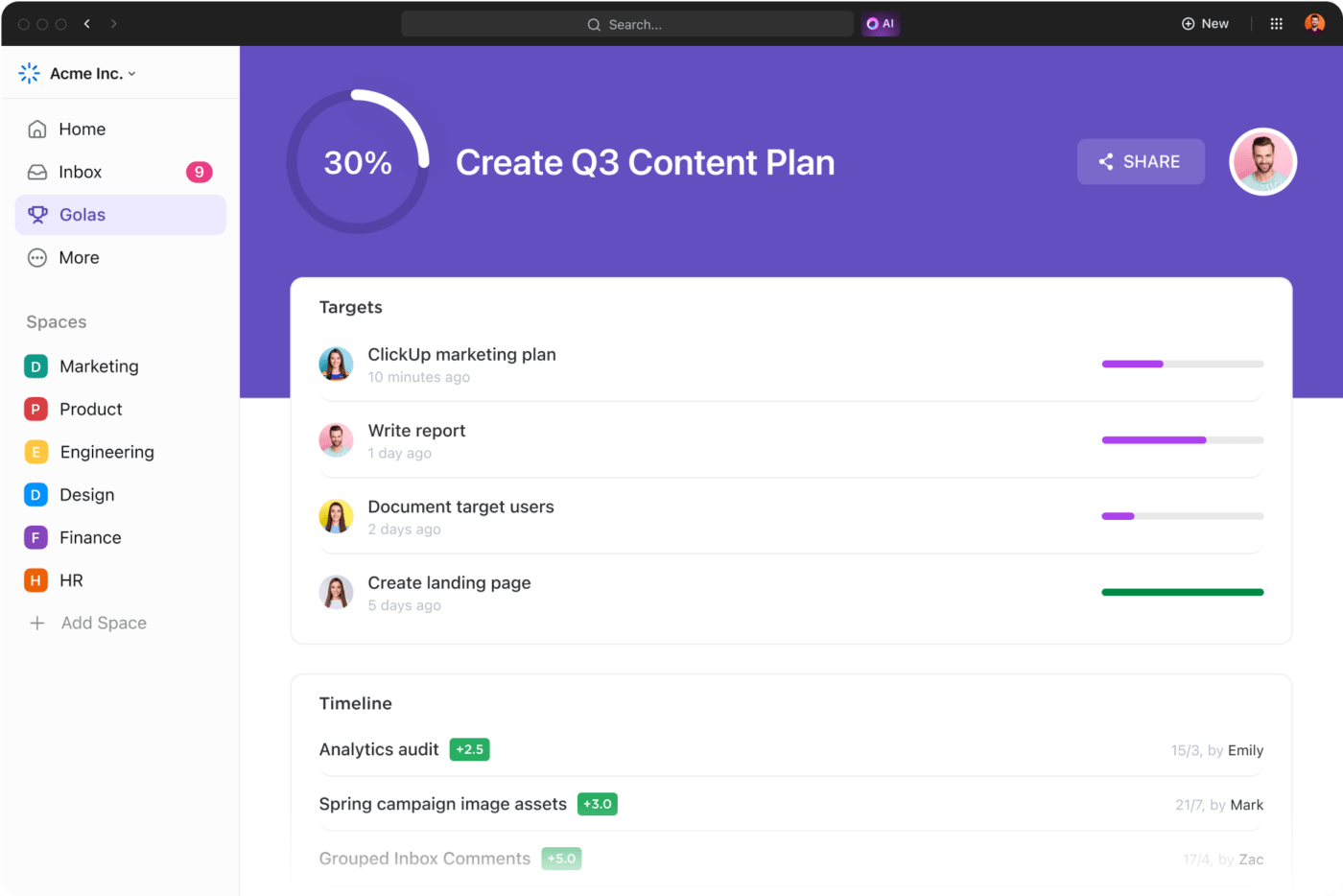
حدد أهداف تكنولوجيا المعلومات الخاصة بك وتتبع التقدم المحرز دون عناء باستخدام ClickUp Goals
قم بقياس مؤشرات الأداء الرئيسية باستخدام لوحات معلومات ClickUp
قم ببناء لوحة تحكم ClickUp وتتبع مؤشرات الأداء الرئيسية في الوقت الفعلي لتقدم الأهداف، والأداء، وقدرة الفريق، وإحصائيات تتبع الوقت، وأي شيء آخر ذي صلة بفريقك أو مشروعك. يحتوي على آلة حاسبة مدمجة لمؤشرات الأداء الرئيسية المعقدة.
بالإضافة إلى ذلك، يمكنك تخصيص لوحة التحكم الخاصة بك بأكثر من 50 بطاقة أو تقريرًا مختلفًا. استفد من التمثيلات الرسومية مثل الاحتراق و مخططات السرعة للتحقق من حالة أهداف تكنولوجيا المعلومات الخاصة بك.

صمم لوحة معلومات ClickUp المثالية واحصل على نظرة عامة في الوقت الفعلي لجميع أعمالك وتقدمك وأدائك
نحن نفهم ذلك - يحتوي ClickUp على العديد من الميزات التي قد تشعر أنها مربكة للاستخدام في البداية. لهذا السبب قمنا بإعداد العديد من قوالب تكنولوجيا المعلومات لحالات استخدام مختلفة لمساعدتك.
على سبيل المثال، يمكنك استخدام قالب قائمة مشاريع ClickUp IT كنقطة انطلاق ممتازة لأي مشروع. من مراقبة المواعيد النهائية للمهام إلى تخصيص الموارد، يمكن أن يساعدك في ترتيب جميع مشاريعك.
إن قالب خارطة طريق ClickUp لتكنولوجيا المعلومات هو أداة مثالية أخرى مناسبة للمبتدئين للتخطيط الاستراتيجي وتحديد الأهداف. فهو يساعدك على تصميم خط سير تكنولوجيا المعلومات الخاص بك بالكامل على جدول زمني تفاعلي، وكل ذلك قابل للتعديل بالكامل حسب احتياجات العمل المتغيرة. 🥳
قم بإنشاء خطط استراتيجية لمبادرات تكنولوجيا المعلومات الخاصة بك باستخدام قالب خارطة طريق تكنولوجيا المعلومات من ClickUp
حدد أهداف قسم تكنولوجيا المعلومات لديك وتجاوزها باستخدام ClickUp
يجب أن يتبع تحديد الأهداف تخطيط مكثف وتتبع التقدم المحرز. لحسن الحظ، يمكن لأداة مثل ClickUp أن تجعل كل هذه الخطوات سهلة التجاوز. اشترك في ClickUp ودعه يدعمك خلال جهودك في التخطيط الاستراتيجي وما بعده. ❣️
